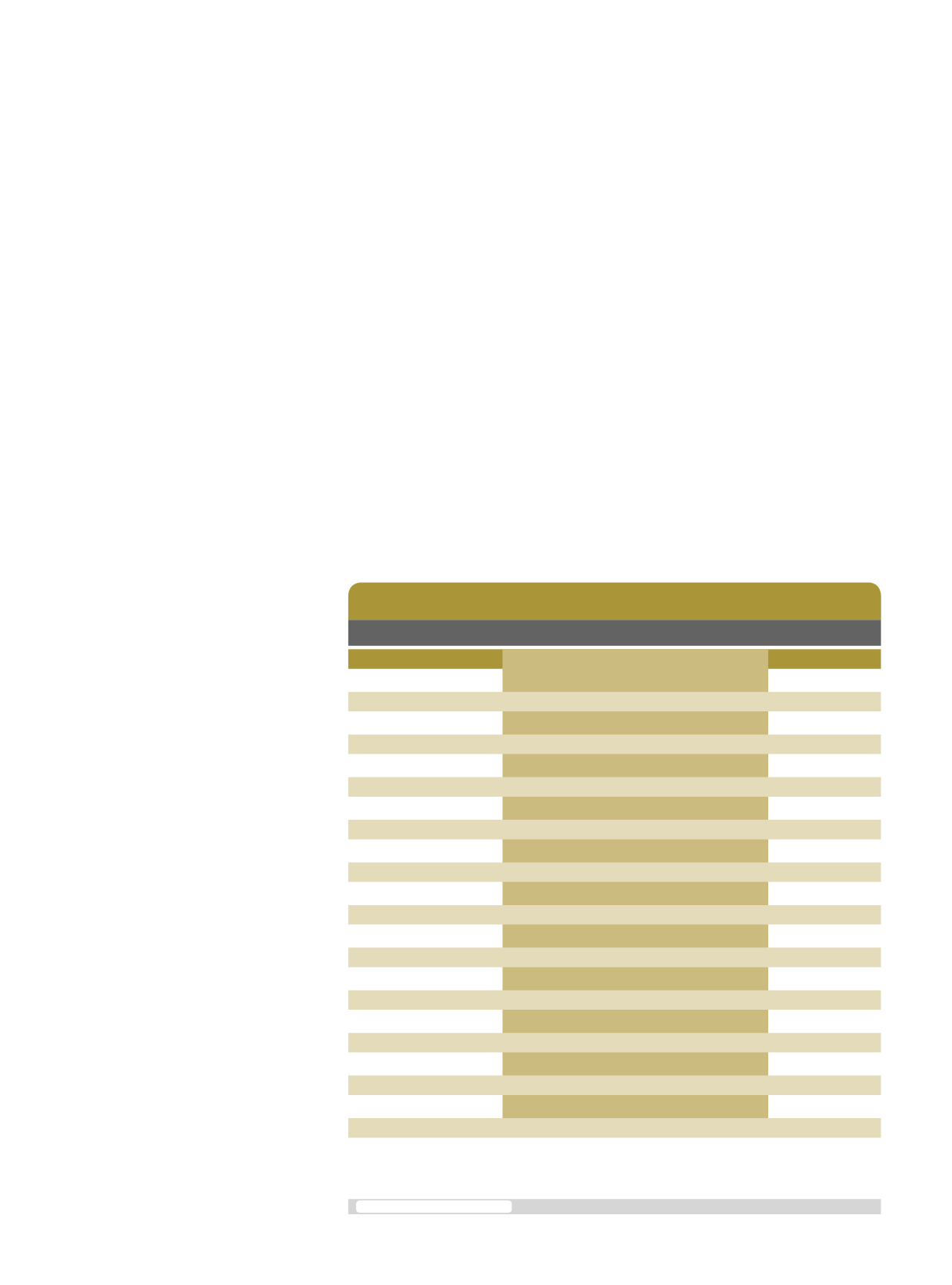
10
Produçãobrasileira de frutas frescas
AONATURAL
Fresh fruit
2015
2016*
Frutas
Áreacolhida (ha) Volume (t)
Volume (t)
Laranja
665.174 16.746.247
15.983.273
Banana
475.976 6.844.491
6.962.134
Abacaxi
69.165 3.621.100
3.532.689
Melancia
95.965 2.119.559
2.119.559
Uva
78.011 1.497.302
987.059
Mamão
30.285 1.463.770
1.463.770
Maçã
35.842 1.264.651
1.064.708
Limão
46.078 1.180.271
1.180.271
Tangerina
48.975
999.686
999.686
Manga
64.305
976.815
976.815
Coco-da-baía
251.665 1.958.663
1.754.425
Maracujá
50.837
694.539
694.539
Melão
20.762
521.596
521.596
Goiaba
17.603
424.305
424.305
Pêssego
17.436
216.241
216.241
Caqui
8.588
192.327
192.327
Abacate
10.354
180.636
180.636
Figo
2.855
29.063
29.063
Pera
1.453
21.160
21.160
Marmelo
116
841
841
Total
1.991.445 40.953.263
39.305.097
*Estimativa –**Conversão:1fruto=2,5kgnaregiãoSul/Sudeste,excetoParaná(ondeé1,6kg)e
SantaCatarina(ondeé1,67);naregiãoCentro-Oeste;e1,8kg,nasdemaisregiões.- ***Quantidadeproduzidas
em1.000frutos
Fonte:IBGE(PAM/2015eLSPA).
B
razilian fruit farming business
reaped smaller than expected
crops over the past years due to
unfavorable climate conditions.
The 20most cultivated fruit trees
grown in Brazil reached an output of 40.953
million tons of fresh fruit in 2015, according
to recent data from the Brazilian Institute
of Geography and Statistics (IBGE). This re-
sult translated into a decrease of 1.7 million
tons of fresh fruit, in comparison to the 42.6
million tons registered in 2014. Smaller vol-
umes were registered for oranges (-1.1%),
bananas (-1.6%), apples (-8.3%), water-
melons (-2.4%), papaya (-8.7%), mangoes
(-13.7%) and melons (-11.6%). On the oth-
er hand, bigger crops were registered for
grapes (3%), pineapples (2.1%), Bahia coco-
nut (0.7%) and lemons (7.1%).
The 2016 crop could even be smaller than
in theprevious year. Of the sixmore represen-
tative fruits, only bananas are supposed to go
up 1.7%, in 2016, according to the Systemat-
ic Agricultural Production Survey (LSPA), con-
ductedbytheIBGE.Thestudyhadanticipated
a smaller crop for oranges (-4.6%), pineap-
ples (-2.5%), grapes (-34.1%), apples (-15.8%)
andBahiacoconut (-10.4%). Thevolumes sur-
veyed by the IBGE tend to show for 2015 and
2016numbersverycloseto,oreveninferiorto
2014, comments Moacyr Saraiva Fernandes,
president of theBrazilianFruit Institute (Ibraf).
“We are detecting lots of problems in the pro-
Brazilianorchards
producedsmaller
volumesoverthe
pastyears,andthe
blamegoestothe
unfavorableweather
conditionsin
severalregions
The
weather
isof nohelp
ductionzones,suchastheprolongeddrought
in the Northeast; and rainfall, hailstorms and
other climate related problems in the South-
eastandSouthoftheCountry“,hesays.
Theadverseweatherconditionshadalsoa
sayinthedeclineofBrazilianfreshfruitexports
in 2016. Fernandes observes that the bad
weather conditions have been jeopardizing
veryimportantfruitcrops,suchasmelons,pa-
payasandapplesin2016.Theseclimateprob-
lemshavehadarecurrentbehavior,afactthat
requires studies and research works in order
to determine to what extent they stem from
the global warming problem”, he comments.
ThetechnicalmanageratBrazilianFruitGrow-
ers and Exporters Association (Abrafrutas),
Jorge de Souza, has it that all questions relat-
ed to the climate are of great concern. “Tem-
perature variations are affecting the physiolo-
gyofthefruittrees”,hewarns.
The area devoted to 22 fruit species
reached a total of 2.581 million hectares in
2015, against 2.646 million hectares in the
previous year, according to the IBGE sur-
vey. Disregarding the area devoted to ca-
shewnuts and chestnuts, the harvested area
reached a total of 1.991 million hectares in
2015. The fruits that occupied the biggest ar-
eas were oranges (665,174 hectares), chest-
nuts (586,523 hectares), bananas (475,976
hectares) and common coconut (251,665
hectares). The highest average performanc-
es were obtained by papaya (48,333 kg/ha)
and apples (35,284 kg/ha). Productivity from
25,000 kg/ha to 26,000 kg/ha were achieved
byoranges, lemons,melons andpineapples.


